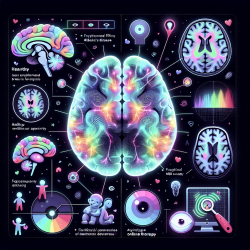Introduction
As practitioners in the field of speech-language pathology, understanding the underlying neurological mechanisms that affect communication is crucial. A recent study titled Altered within- and between-network functional connectivity in atypical Alzheimer’s disease provides insights into brain connectivity disruptions in atypical Alzheimer's disease (AD) phenotypes, specifically posterior cortical atrophy (PCA) and logopenic progressive aphasia (LPA). This research highlights how these disruptions can inform therapy approaches and encourage further exploration in the field.
Key Findings
The study conducted by Singh et al. (2023) at the Mayo Clinic analyzed the functional connectivity of brain networks in 144 patients with PCA and LPA using resting-state functional MRI. The findings revealed significant disruptions in connectivity within and between networks, with distinct patterns observed in each phenotype.
- PCA: Reduced connectivity was noted within the visual network, with increased connectivity between the visual network and the default mode network (DMN). This suggests potential compensatory mechanisms to maintain cognitive function.
- LPA: Reduced connectivity within the language network was observed, alongside increased connectivity between the language and salience networks, indicating possible network reorganization.
Implications for Speech-Language Pathology
Understanding these connectivity patterns can enhance our approach to therapy, particularly in children who may exhibit atypical communication development. Here are some practical applications:
- Tailored Interventions: Recognizing specific network disruptions can guide the development of personalized therapy plans that target affected areas, such as visual or language networks.
- Compensatory Strategies: Leveraging increased connectivity between networks can inform the use of compensatory strategies to support communication skills.
- Further Research: Encouraging practitioners to engage in research that explores similar connectivity patterns in developmental disorders can lead to improved therapeutic outcomes.
Encouraging Further Research
This study underscores the importance of continued research into brain connectivity and its impact on communication disorders. Practitioners are encouraged to explore how these findings can be applied to other populations, such as children with developmental language disorders, to enhance therapeutic interventions.
To read the original research paper, please follow this link: Altered within- and between-network functional connectivity in atypical Alzheimer’s disease.










